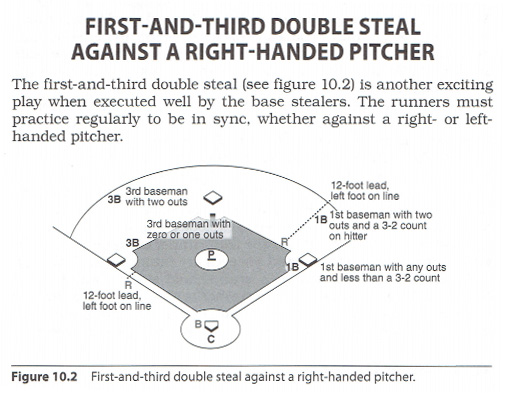|
By: Mike Roberts Originally Published in: Baserunning Provided by: Human Kinetics The first and third double steal (see figure 10.2) is another exciting play when executed well by the base stealers. The runners must practice regularly to be in sync, whether against a right- or left-handed pitcher.
Runner at First With a teammate at third base and a right-handed pitcher on the mound, the runner at first base has many options when initiating a potential double steal. Before the runner at first starts the front end of a potential double steal, he anticipates the pitcher's and defense's movement. The runner has a host of steals at his disposal to keep the pitcher and defense off guard. He can fake a steal, use a controlled jump lead steal, try a leaning lead steal, execute a straight steal, or attempt a delayed steal, along with many other techniques designed to place pressure on the defense. Each of these steals gives the defense a different look and may give the runner at third base a better opportunity to score. With a runner at third base, the runner moving from first on any kind of steal except a straight steal should look back as if carrying out the hit-and-run to see if the catcher is throwing to second base, holding the ball, or throwing to third base. Once the runner on first reads the catcher's reaction, he turns his head back toward the grass in front of second base to see if one of the middle infielders moved to possibly cut off the ball short of second base. If the second baseman or shortstop has moved into this area, the infielder will cut off the ball almost 100 percent of the time. The runner does not want to stop short of the base and get in a rundown when the ball did not go to the base so he should continue straight into the base after reading that the infielder is in the grass. If the runner doesn't see an infielder in the infield grass in front of second base and the catcher is throwing toward second base, the runner should stop and try to get into a rundown. This gives the runner at third base a good opportunity to score. |








